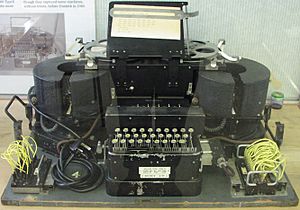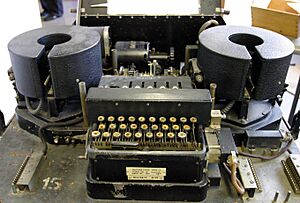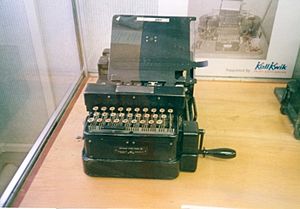Typex facts for kids
Typex (also called Type X or TypeX) machines were special British machines used to send secret messages. They were used starting in 1937. Typex was like the German Enigma but had many improvements that made it much safer. These secret code machines were used until the mid-1950s when newer systems came along.
Contents
How Typex Machines Worked
Typex machines were a type of rotor machine. This means they used spinning wheels, called rotors, to scramble messages. Imagine a puzzle where each letter changes based on how the wheels are lined up!
Key Features of Typex Machines
- More Rotors: Typex machines usually had five rotors. The Enigma machine only had three or four. More rotors meant more ways to scramble the message.
- Reflector: Like Enigma, Typex sent the message through the rotors twice. A special part called a "reflector" sent the signal back through the rotors.
- Stronger Contacts: Each electrical contact on a Typex rotor was doubled. This made the machine more reliable and less likely to break.
- Stationary Rotors: The first two rotors often stayed still. They added extra scrambling without making the machine too complicated. This was similar to a "plugboard" on the Enigma.
- Better Notches: A big improvement for Typex was that its rotors had many notches. These notches helped turn the next rotor. This made it much harder for enemies to figure out the secret codes. Enigma's fixed notches sometimes left clues.
- Two-Part Rotors: Some Typex rotors came in two parts. A "slug" with wires fit inside a metal case. These cases could have different numbers of notches. Operators could choose from a set of ten slugs.
Using a Typex Machine
Operators could type messages very quickly, sometimes 20 words a minute! The secret message (or the unscrambled message) was printed right onto paper tape. Some smaller versions, like the Mark III, let you type with one hand and turn a handle with the other.
To keep the machines working, they needed to be cleaned and oiled regularly. Special oil was used for most parts, and a jelly-like substance called Vaseline was used on the rotor contacts. This stopped sparks from damaging the machine.
The Story of Typex Machines
In the 1920s, the British government wanted a better way to send secret messages. Their old "book cipher" systems were slow and not very safe.
Developing the First Typex
In 1926, a group was formed to find new cipher machines. One idea came from a man named Oswyn G. W. G. Lywood. He suggested changing the commercial Enigma machine to add a printer.
In 1934, Lywood started working on his machine for the RAF. The first test machine was ready in April 1935. By early 1937, about 30 Typex Mark I machines were given to the RAF. At first, they called it the "RAF Enigma with Type X attachments."
Different Models of Typex
- Typex Mark II: This model was designed in 1937. It was quite large and heavy, weighing about 54 kilograms (120 pounds). It had two printers, one for the original message and one for the secret message. The RAF, Army, and other government groups started using it. Many Mark II machines were made during World War II.
- Typex Mark III: This was a smaller, portable version. It used the same spinning drums as the Mark II. You could power it by turning a handle, or you could attach a motor. It was slower than the Mark II, sending about 60 letters a minute.
- Typex Mark VI: This was another handle-operated machine. It was even smaller and lighter, weighing about 13.6 kilograms (30 pounds).
- Plugboards: From November 1941, newer Typex machines started to include "plugboards." These added even more ways to scramble messages, making them harder to crack.
- Combined Cipher Machine (CCM): During World War II, the British and Americans worked together. They created the CCM so their secret machines could talk to each other. Typex machines were changed to work with the American ECM Mark II machine.
- Typex 22 and 23: These were later models that also had plugboards for better security. The Mark 23 was a Mark 22 changed to work with the CCM.
Typex machines were used for a long time. In New Zealand, for example, the military used Typex machines until the early 1970s! Experts believe about 12,000 Typex machines were built by the end of World War II.
Why Typex Was Better Than Enigma
Typex machines had several important advantages over the German Enigma machines:
- One Operator: Most Enigma machines needed two people to work them: one to type and one to write down the message. Typex only needed one operator.
- No Copying Mistakes: With Typex, the secret message was printed automatically. This meant fewer errors from people writing things down incorrectly.
- Faster Communication: Enigma messages had to be written, then scrambled, then sent (often by Morse code), then received, then unscrambled, and finally written again. Typex messages were typed, scrambled, and sent all in one step! The same was true for receiving messages.
Security and Use of Typex
Less than a year into World War II, the Germans could read almost all British military secret messages, except for those sent by Typex. The British armed forces and countries like Australia, Canada, and New Zealand used Typex.
In 1943, the Americans and British agreed to use the Combined Cipher Machine (CCM). This meant that the British Typex and American ECM Mark II machines could send messages to each other.
German code-breakers did try to crack Typex messages. They even captured a Typex machine without its rotors during the Battle of France. However, after six weeks, they gave up because it was too difficult. One German code-breaker even thought Typex was more secure than Enigma because it had more rotors.
Even though Typex was considered very secure, there were some questions about it. German prisoners of war in North Africa claimed that Typex messages could be read. However, reports suggest that these claims were not fully confirmed.
Typex machines continued to be used for many years after World War II ended.
Images for kids







